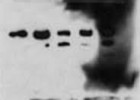 In immunological experiments, high background values ​​will occur and the detection of experimental results will be affected. This is because when a related immunological reagent is used, the protein is combined with the unadsorbed solid carrier to cause non-specific binding. Immunological experiments often block such solid support sites by blocking reagents to reduce or eliminate the effects of non-specific binding background.
In immunological experiments, high background values ​​will occur and the detection of experimental results will be affected. This is because when a related immunological reagent is used, the protein is combined with the unadsorbed solid carrier to cause non-specific binding. Immunological experiments often block such solid support sites by blocking reagents to reduce or eliminate the effects of non-specific binding background.
Common blocking agents include skimmed milk powder, bovine serum albumin BSA, animal serum and Fab fragment single chain secondary antibodies. Because natural biotin and alkaline phosphatase may be present in milk powder, it is not suitable for blocking of phosphorylated protein detection and detection experiments using biotin and alkaline phosphatase systems. In addition, skimmed milk powder may contain bovine IgG, which has a strong cross-reaction with anti-bovine, goat, sheep, horse and other secondary antibodies, which will cause a certain background. Skim milk is used as a sealer in a narrower range than other sealers. Amy Jie provides you with a comprehensive immunoassay blocker.
In immunological assays, blocking agents are often used to block the solid phase carrier sites of unadsorbed proteins to reduce the effects of non-specific binding background. For example, the ELISA test relay package is followed by a solution such as 0.05-0.5% BSA to occupy the void that is not coated; as in the WB test, 5% skim milk powder or BSA seal membrane is used to remove other parts occupied by the transfer protein. In addition to solid phase carriers for blocking unadsorbed proteins, blocking reagents are also widely used to block other non-specific binding. For example, in ELISA experiments, specific antibodies produce non-specific binding to IgM, IgG-type rheumatoid factor, and complement components in serum samples; in IHC, IF, etc., specific antibodies bind to Fc receptors in the sample, and In IHC and IF double or triple staining experiments, sputum serum was also widely used to block reagents to reduce non-specific binding between antibodies; in addition, Fab fragment single-chain secondary antibodies were also used for efficient blocking in fluorescent double staining.
Bovine serum albumin BSA
BSA is the most common blocking reagent. Compared with skim milk powder, BSA component is relatively simple, suitable for ELISA experiments, immunological detection experiments of biotin, alkaline phosphatase system or other experiments with higher specificity. It is worth noting that bovine IgG may also be present in BSA of common grade, so it has a strong cross-reaction with anti-bovine, goat, sheep, horse and other secondary antibodies, which will cause certain background. It is recommended to use IgG-free. BSA products.
Agilent's Jackson brand and Equitech-Bio brand of high quality, different specifications of IgG-free BSA.
Animal serum
The serum source for blocking should be selected as the blocking agent from the same species source as the secondary antibody. The main principle of blocking serum: 1. The sample to be tested will be non-specific and protein-binding, resulting in too high background. This is the same as the BSA principle. 2. There may be Fc receptors in the sample to be tested, which can bind to the constant region of the antibody, and because the blocking serum contains antibodies, the binding between the primary antibody and the secondary antibody and the sample Fc receptor can be blocked by serum. This is something that BSA cannot satisfy. It should be noted that some blocked serum may contain sodium azide, so it is not suitable for the immunological detection system of HRP enzyme label.
Amy Jie provides you with comprehensive closed serum and is available from stock.
Fab fragment single chain secondary antibody
Since bivalent antibodies (full IgG or F(ab')2 fragments) have two binding sites, they cannot be used for blocking. The Fab fragment single-stranded secondary antibody has only one binding site, so the immunoglobulin can be completely blocked. For example, in a double-labeled experiment with two monoclonal antibodies, immunoglobulins that can be used to block the surface of a sample can also be used to block endogenous immunoglobulins on tissue sections or cell surfaces. The Fab fragment secondary antibody is very suitable for blocking immunoglobulins such as IgG and IgM. Generally used for serum blocking, the use of Fab antibody at a concentration of 10-20ug / ml, can effectively block endogenous IgG protein. In addition, the subtle use of Fab fragment monovalent secondary antibody can solve the problem of two primary antibodies from the same genus in the IF double standard experiment.
As a regional agent for a variety of imported brands in China, Aimei provides you with a full range of immunological testing solutions for Chinese clients to help researchers select the right secondary antibody for different applications (including WB, IF, IP- WB, IHC, etc., as well as closure related reagents and recommendations, and provide some common problems for secondary antibody solutions and product solutions (such as heavy chain interference after IP-WB, economical reagent solutions for Odyssey infrared fluorescence scanning imaging system) , multi-standard products of IF experiments, etc.). If you are interested in the above products and solutions, please contact Ai Meijie Technology Co., Ltd. for inquiries about autophagy-related experimental solutions, or request the latest product information. Article source: http://
1-Piece Ostomy Pouch,One Piece Ostomy Bags,One Piece Ostomy Pouch,1 Piece Ostomy Bag
Henan Maidingkang Medical Technology Co.,Ltd , https://www.mdkmedical.com